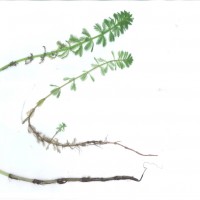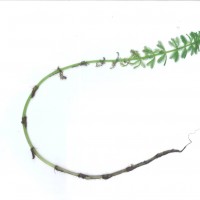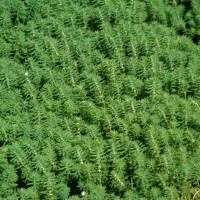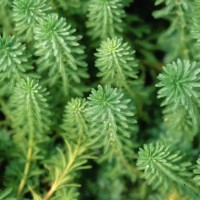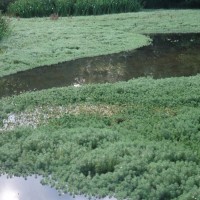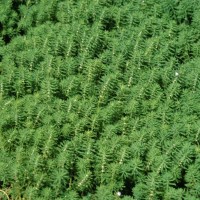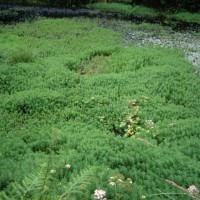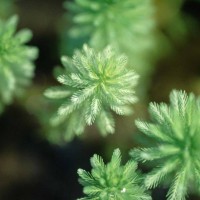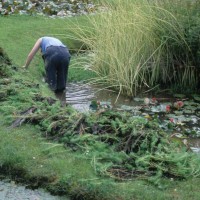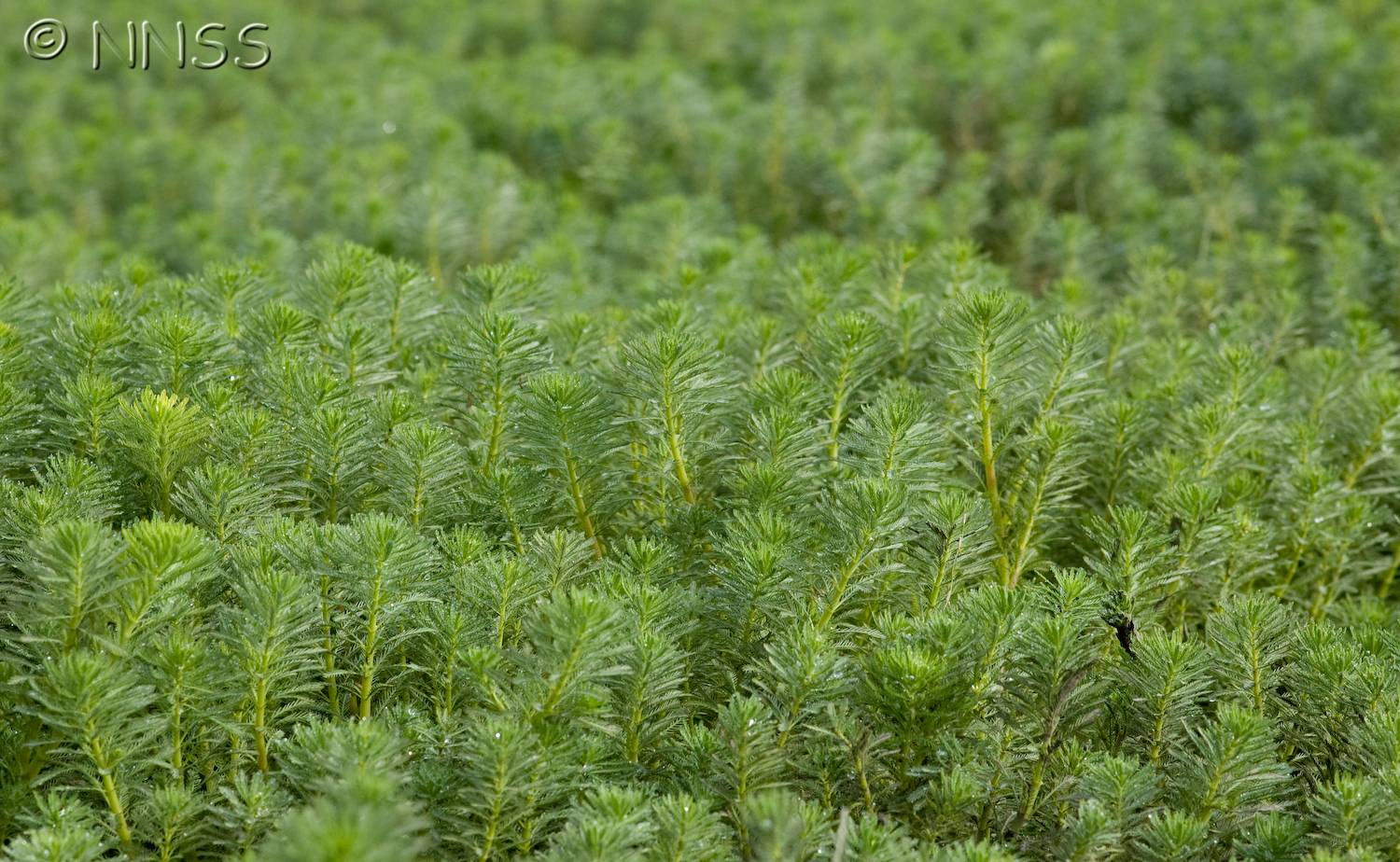
Parrot's Feather - Myriophyllum aquaticum
Expand and collapse the sections below by clicking on the title or + / - icons.
Short description of Myriophyllum aquaticum, Parrot's Feather
Parrot's feather is a much-branched aquatic plant with finely pinnately-dissected whorls of leaves, which produces emergent shoot apices up to 13 cm high, usually glaucous or pale green because of abundant glands and bearing flowers.
Impact summary: Myriophyllum aquaticum, Parrot's Feather
The impact of parrot's feather in GB is difficult to assess; it certainly occupies large areas of the beds of standing and flowing water bodies which might otherwise support native plants. In Belgium it has been shown to have a significant negative impact on native plant and macroinvertebrate diveristy of ponds although less so than Ludwigia grandiflora and Hydrocotyle ranunculoides (Stiers et al., 2011).
Habitat summary: Myriophyllum aquaticum, Parrot's Feather
In its native range M. aquaticum grows in floodplain lagoons, river backwaters, lakes, ponds, marshes, fens and ditches. In GB, it occurs in eutrophic ponds, ditches, reservoirs, canals and flooded mineral workings; it occasionally also occurs in flowing waters.
Overview table
| Environment | Freshwater |
|---|---|
| Species status | Non-Native |
| Native range | Southern America, Central America |
| Functional type | Land plant |
| Status in England | Non-Native |
| Status in Scotland | Non-Native |
| Status in Wales | Non-Native |
| Location of first record | v.c.17 (Lingfield) |
| Date of first record | 1960 |
Origin
Parrot's feather is native to the lowlands of South America.
First Record
Parrot's feather was first recorded in GB from a pond at Lingfield in Surrey in 1960. Its subsequent spread has been much slower than Crassula helmsii which was first recorded at about the same time (Dawson, 1993), largely because it does not produce the numerous small vegetative fragments which act as propagules in that species (Preston & Croft, 1997).
Pathway and Method
Parrot's feather has been cultivated in GB since 1878. It is introduced when surplus garden plants are dumped in the wild and the extent to which it spreads naturally to new sites is unknown.
Species Status
Parrot's feather is established throughout the southern coastal states and inland from the east as far as the Great Lakes in North America, and in Mexico, Costa Rica and Nicaragua; it also occurs in Cambodia, Indonesia (Java), Japan, Malaysia, Philippines, Thailand, Vietnam, Australia New Zealand, Egypt, South Africa, Zimbabwe and Madagascar; as well as Austria, France, Germany, Portugal and the Netherlands in Europe. In the UK, it occurred only rarely from its discovery in a pond in Surrey in 1960 until 1986, when it was still known from fewer than ten 10km squares. However by 1995 this had increased to 87, 270 by 1999, 330 by 2010 and 528 by 2017.
Dispersal Mechanisms
It has no natural dispersal mechanisms in GB, but plant fragments may be spread on machinery, boats, clothing or even by birds or other animals.
Reproduction
Seed-set is apparently rare even in its native range and most reproduction is by vegetative fragmentation.
Known Predators/Herbivores
None known.
Resistant Stages
None known.
Habitat Occupied in GB
Parrot's feather usually grows in eutrophic conditions in small ponds, canals, ditches, lakes and reservoirs, but will also occasionally grow in streams or lakes.
Parrot's feather is well established in large parts of the area south of a line from the Severn Estuary to the Wash; north of this populations are fairly sparse but extent north into southern Scotland, the Isle of Man and west Wales with a few populations in Ireland.
Environmental Impact
In areas of significant infestation, parrot's feather is reputed to disrupt natural erosion-deposition processes, disrupt the movement of animals, out-compete native aquatic plants, block light needed for photosynthesis, disrupt predator-prey relationships, prevent wind mixing, leading to localised of oxygen depletion, create mosquito breeding areas and increase water temperature by absorbing sunlight, while die back can increase nutrient loads to the water. None of these impacts are likely in GB unless populations increase significantly.
Health and Social Impact
Dense growth of parrot's feather can cause flooding and ponding of water, leading to increased health hazards, although these are not likely to be a serious problem in GB. It can also have significant impacts on the aesthetics qualities of wetlands and prevent water-borne recreation.
Economic Impact
Parrot's feather can interfere with irrigation, transport, hydro-electric power production, fisheries, recreation, interfere with fisheries, cause problems for hydroelectric power production and forestry development.
Identification
Stace, C.A. (2010) New flora of the British Isles, Third Edition, Cambridge University Press, Cambridge.
Lansdown, R.V. (2009) A field guide to the riverine plants of Britain and Ireland, Ardeola, Stroud, Gloucestershire.
Biology, ecology, spread, vectors
Non-native species secretariat risks and action plans (https: secure.fera.defra.gov.uk nonnativespecies downloadDocument.cfm?id=274).
Dawson, F.H. 1993. Comparison of the rates of naturalisation of the invasive alien aquatics, Crassula helmsii and Myriophyllum aquaticum. BSBI News 63: 47-48.
Preston, C.D. & Croft, J. 1997. Aquatic Plants in Britain and Ireland.
Stiers, I., Crohain, N & Josens, G. 2011. Impact of three aquatic invasive species on native plants and macroinvertebrates in temperate ponds. Biological Invasions 13: 2715-2726.
Management and impact
Non-native species secretariat risks and action plans (https: secure.fera.defra.gov.uk nonnativespecies downloadDocument.cfm?id=274).
Dawson, F.H. 1993. Comparison of the rates of naturalisation of the invasive alien aquatics, Crassula helmsii and Myriophyllum aquaticum. BSBI News 63: 47-48.
Preston, C.D. & Croft, J. 1997. Aquatic Plants in Britain and Ireland.
Stiers, I., Crohain, N & Josens, G. 2011. Impact of three aquatic invasive species on native plants and macroinvertebrates in temperate ponds. Biological Invasions 13: 2715-2726.
General
Non-native species secretariat risks and action plans (https: secure.fera.defra.gov.uk nonnativespecies downloadDocument.cfm?id=274).
Spotted this species?
Distribution map
View the Distribution map for Parrot's Feather, Myriophyllum aquaticum from BSBI
Risk assessment
Risk assessment for Myriophyllum aquaticum. See a full list of non-native species Risk assessments.
Management
Links to management practices for Myriophyllum aquaticum. See all management information.
Legislation
This species is:
- A Species of Special concern
- Listed under Schedule 9 of the Wildlife and Countryside Act 1981
- Prohibited from sale under The Wildlife and Countryside Act 1981 (prohibition on Sale etc. of Invasive Non-native Plants) (England) Order 2014
Read more about Non-native species legislation.

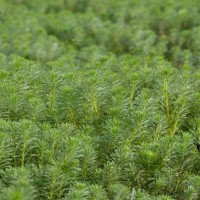
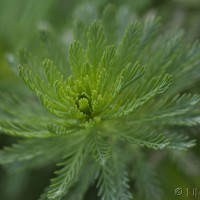
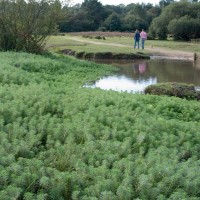
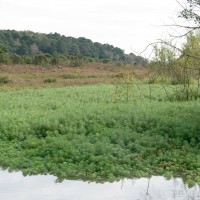
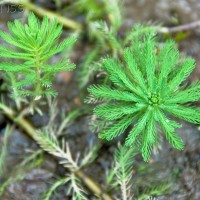
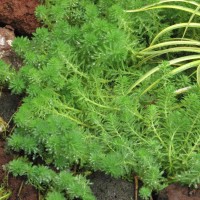
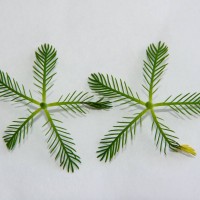
__FillMaxWzIwMCwyMDBd.jpg)
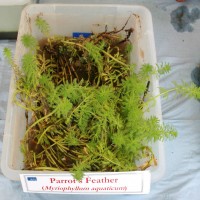
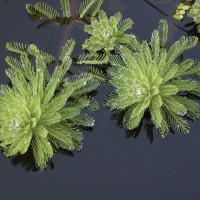
__FillMaxWzIwMCwyMDBd.jpg)
